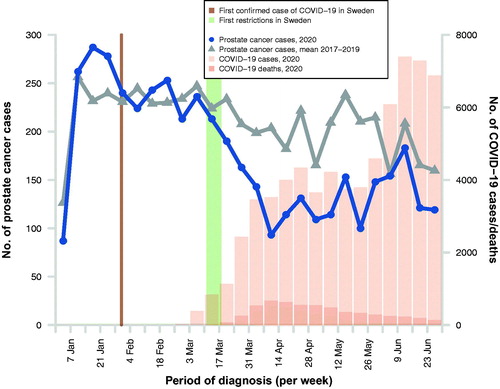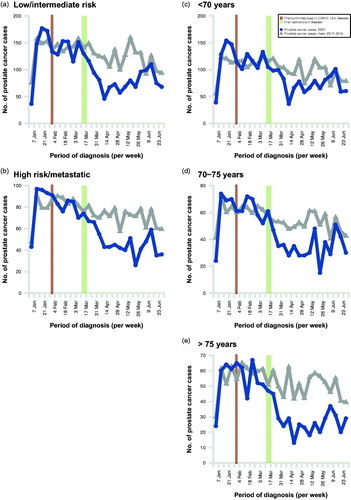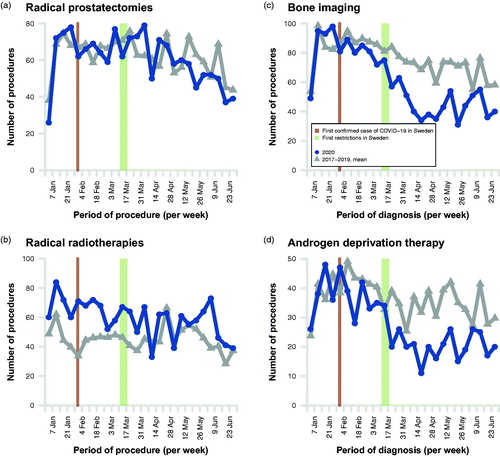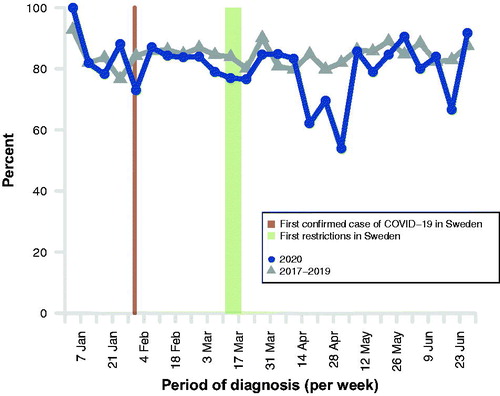Figures & data
Figure 1. Number of cases of prostate cancer registered in the National Prostate Cancer Register (NPCR) of Sweden per week from 1 January to 30 June 2020, compared with the mean number in the same calender period in 2017–2019, as reported until January 31 of the year after each study period. #Data on number of COVID-19 cases and deaths from COVID-19 are taken from the Public Health Agency of Sweden (https//:www.folkhalsomyndigheten.se).

Table 1. Number of prostate cancer cases registered in The National Prostate Cancer Register (NPCR) of Sweden from March 18th to June 2nd in 2017–2020, reported until January 31st of the year after each study period.
Figure 2. Number of cases of prostate cancer registered in the National Prostate Cancer Register (NPCR) of Sweden per week from 1 January to 30 June 2020, compared with the mean number in the same calender period in 2017–2019, as reported until January 31 of the year after each study period. #Data on number of COVID-19 cases and deaths from COVID-19 are taken from the Public Health Agency of Sweden (https//:www.folkhalsomyndigheten.se). Aggregated COVID-19 data for the entire population were only available at health care region level. Part of region Halland belongs to health care region West and part belongs to health care region South, therefore data for Halland was included in both regions.

Figure 3. Number of prostate cancer cases registered in the National Prostate Cancer Register per week according to prostate cancer risk category and age at diagnosis, from 1 January to 30 June 2020, compared with the mean number in 2017–2019, as reported until January 31 of the year after each study period. Prostate cancer risk categories: low/intermediate-risk: clinical local stage T1-2, Gleason score 2–7 and/or PSA 10 to ≤20 ng/ml; high-risk/metastatic: clinical T-stage ≥ pT3 and/or Gleason score 8–10 and/or PSA >20 ng/ml and/or N1 and/or M1

Figure 4. Number of radical prostatectomies, radical radiotherapy courses, bone imagining and start of androgen deprivation therapy as primary treatment per week registered in the National Prostate Cancer Register from 1 January to 30 June 2020, compared with the mean number in 2017–2019, as reported until January 31 of the year after each study period. Androgen deprivation therapy includes GnRH agonist or antagonist, bicalutamide and bilateral orchiectomy as reported in NPCR.

Figure 5. Percent of men below age 80 years with high-risk prostate cancer who underwent bone imaging per week registered in the National Prostate Cancer Register from 1 January to 30 June 2020, compared with the mean number in 2017–2019, as reported until January 31 of the year after each study period.

Supplemental Material
Download Zip (130 KB)Data availability statement
Data on an aggregated level can be made available on a remote server upon request to the corresponding author
